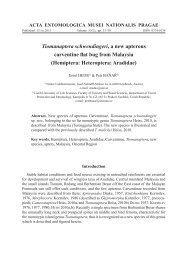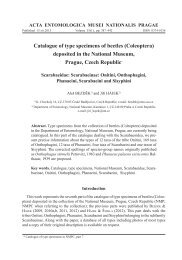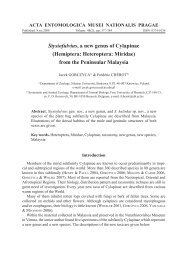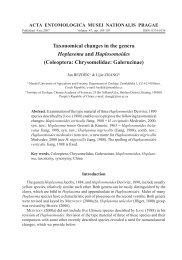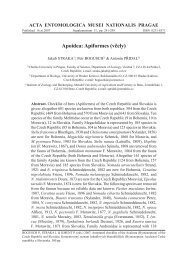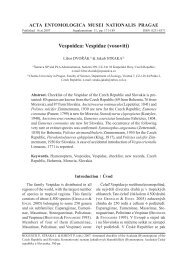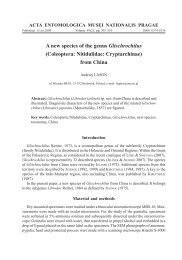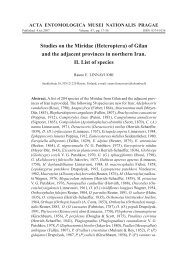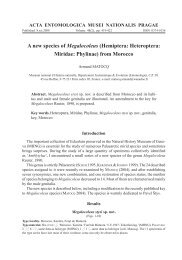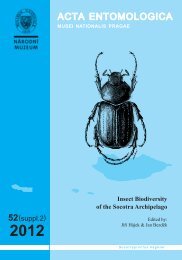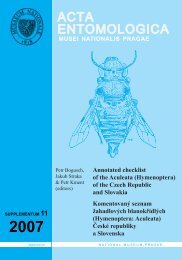Revision of the Palaearctic species of the Coccinella ...
Revision of the Palaearctic species of the Coccinella ...
Revision of the Palaearctic species of the Coccinella ...
Create successful ePaper yourself
Turn your PDF publications into a flip-book with our unique Google optimized e-Paper software.
142<br />
KOVÁŘ: <strong>Coccinella</strong> transversoguttata <strong>species</strong> group and notes on o<strong>the</strong>r <strong>Coccinella</strong><br />
shallowly emarginate. Ventrite 6 with shallow postero-median subtrapezoidal impression and<br />
distinctly bisinuate posterior margin. Legs moderately slender, distal end <strong>of</strong> middle and hind<br />
femora reaching outer margin <strong>of</strong> epipleura. Hind tibia 6.67 times as long as wide, inner margin<br />
apart from basal portion straight, outer one slightly but regularly arcuate. Tarsomere 3<br />
slightly surpassing midlength <strong>of</strong> free part <strong>of</strong> tarsomere 2. Tarsal claw moderately slender,<br />
obtusangulately curved in middle, with ra<strong>the</strong>r large subquadrangular tooth reaching midlength<br />
<strong>of</strong> claw.<br />
Male genitalia: Tegmen robust. Median lobe <strong>of</strong> aedeagus in ventral view with basal half<br />
subquadrangular, shorter than wide, apical hastate half narrowly pear-shaped with sides irregularly<br />
sinuate, with parallel-sided terminal portion extended well over apices <strong>of</strong> parameres. In<br />
lateral view, dorsal margin distinctly sinuate, apex slightly curved dorsally. Paramere thick,<br />
finger-shaped, only slightly curved at basal 0.4. Trabes simple but robust, slightly curved<br />
dorsally, as long as basal piece and paramere combined. Sipho comparatively short. Siphonal<br />
capsule large, inner hook-shaped branch ra<strong>the</strong>r short, roundly pointed and moderately curved<br />
dorsally at apex; dorsal rib well developed, asymmetrically semicircular. Siphonal tube ra<strong>the</strong>r<br />
short, widely obtusangulately rounded at basal 0.4, <strong>the</strong>n straight; preapical supporting sclerites<br />
gradually dilated ventrally but not laterally, bearing two ra<strong>the</strong>r large membranose swellings<br />
on each side, terminal ampulla moderate, triangular. Anterior pair <strong>of</strong> swellings moderate,<br />
posterior ones strikingly magnified and for most part free.<br />
Female genitalia. FÜRSCH (1981), giving no illustration, compared <strong>the</strong>m with those <strong>of</strong> true<br />
C. marussii and regarded <strong>the</strong>m as identical with those figured by KAPUR (1973).<br />
Length. Holotype: 5.71 mm; width: 4.46 mm.<br />
Differential diagnosis. FÜRSCH (1981) studied a series <strong>of</strong> both sexes from Turkey (‘Bielefeld,<br />
gelang am 4.8.1965 in der Umgebung von Bitlis (Nahe Van-See, Ostanatolien)’, deposited in<br />
‘Zoolog. Staatssamlung München und der Sammlung Fürsch’, number <strong>of</strong> specimens not given).<br />
The presence <strong>of</strong> tricuspidate pattern <strong>of</strong> elytra and <strong>the</strong> similarity <strong>of</strong> sperma<strong>the</strong>cae lead him<br />
to <strong>the</strong> conclusion that <strong>the</strong> material was identical with C. marussii. However, <strong>the</strong> schematic<br />
illustrations <strong>of</strong> <strong>the</strong> aedeagus (Fig. 1), median lobe <strong>of</strong> aedeagus (Fig. 2) and <strong>the</strong> apex <strong>of</strong> sipho<br />
(Fig. 3) given by FÜRSCH (1981) undoubtledly show that it is a separate <strong>species</strong>. Its peculiar<br />
coloration <strong>of</strong> <strong>the</strong> elytra which are strongly convex, and broadly oval at <strong>the</strong> apex and <strong>the</strong> tips <strong>of</strong><br />
hind femora concealed from above somewhat resemble C. magnifica L. Redtenbacher, 1843.<br />
In <strong>the</strong> latter <strong>species</strong>, <strong>the</strong> apical portion <strong>of</strong> median lobe is quite narrow. On <strong>the</strong> o<strong>the</strong>r hand, C.<br />
hodeki sp. nov. belongs to <strong>the</strong> C. transversoguttata <strong>species</strong> group and shares a similar colour<br />
pattern with dark forms <strong>of</strong> C marussii. The hastate portion <strong>of</strong> <strong>the</strong> median lobe is also similar<br />
with that <strong>of</strong> C. magnopunctata, and <strong>the</strong> subterminal swellings <strong>of</strong> <strong>the</strong> sipho exhibit some similarity<br />
with C. transversoguttata. The phylogenetic relationship <strong>of</strong> C. hodeki sp. nov. thus<br />
remains unclear and detailed study <strong>of</strong> o<strong>the</strong>r related <strong>species</strong> is necessary.<br />
Etymology. The <strong>species</strong> in named after Ivo Hodek (Czech Academy <strong>of</strong> Sciences, České Budějovice),<br />
an outstanding specialist in <strong>the</strong> biology <strong>of</strong> ladybirds.<br />
Distribution. Known hi<strong>the</strong>rto only from east Anatolia in Turkey (provinces Bitlis and Erzurum).<br />
The material quoted by FÜRSCH (1981) is not included in <strong>the</strong> type material.



